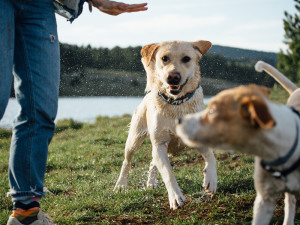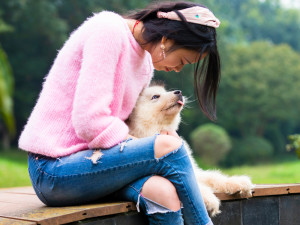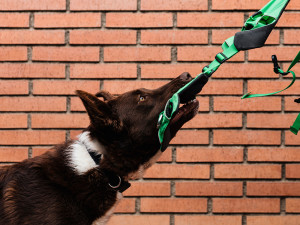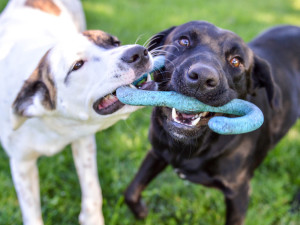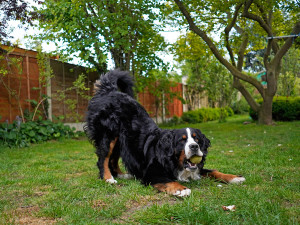Does Your Dog Think Every Day Is Hump Day? Dog Humping and How to Stop It.
In moderation, it’s normal. Excessively? It’s not.
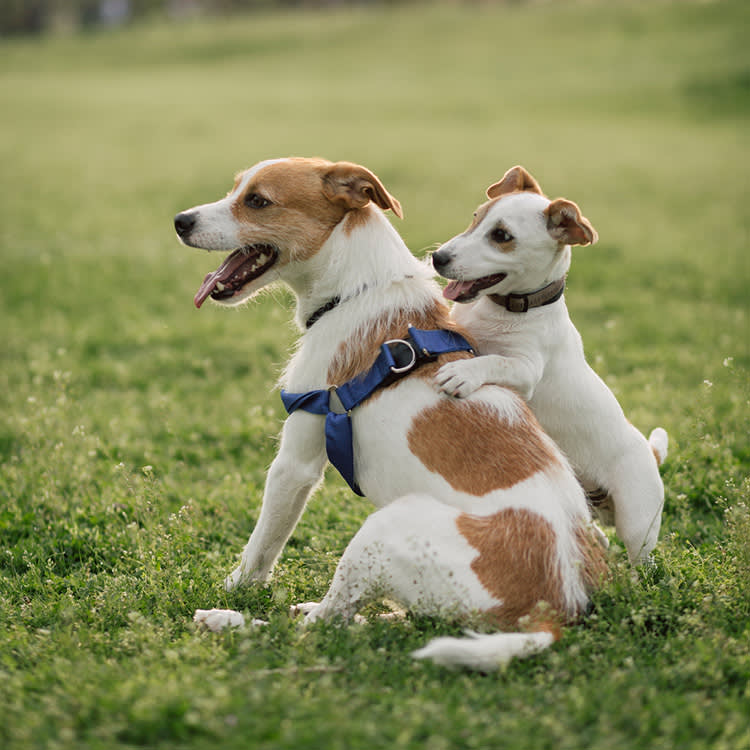
Share Article
In This Article:
Dog Humping Is Normal Why Do Dogs Hump? Common Myths About Why Dogs Hump How to Deal with a Dog Dumping Other Dogs How to Train Your Dog to Stop Humping What to Do When Dog Humping Becomes a Problem Does Spaying and Neutering Stop Humping Behavior?
Humping is a normal dog behavior that nearly all dogs will do it at some point in their lives. But that doesn't mean we have to like it.
This behavior doesn’t always require intervention — especially if it only happens occasionally, and the dogs involved don’t seem bothered by it. However, there are times when humping escalates into a problematic behavior, and then you may need to take action. This is what you can do about it.
Main takeaways
Humping is a normal dog behavior when it is done in moderation and with the appropriate context.
Sometimes humping is a sign of a problem, especially when it becomes excessive.
There are many strategies to stop your dog from humping.
Dog humping is normal. But that doesn’t make it less awkward.
Dog humping can make everyone feel weird. It’s just so awkward, especially when your dog has chosen to mount the pup of the most judgy person at the park. Do you step in and intervene? Do you let the dogs work it out themselves while you try not to stare? Read on to learn about some strategies to navigate these cringe-worthy moments.

Why do dogs hump?
Humping is a normal dog behavior that occurs in a variety of contexts between dogs. Technically referred to as mounting, it tends to happen when a dog’s arousal, or excitement level, is very high. The biological instinct to hump is to reproduce, but it can occur in many other contexts, too. Here are some of those motivations.
Instinct
A dog’s basic instinct to mount another dog is typically tied to a hormone-fueled drive to reproduce. Intact female dogs go into heat, during which time they are receptive to mating, and intact male dogs can sense this. This triggers a very strong instinct to mate, and thus mounting ensues. Dogs who are spayed and neutered have a muted sex drive, but some may still become aroused and attempt to mount. Females will not go into heat if they are spayed.
Play
Mounting can be a normal part of play between dogs, too. When they play, dogs may act out instinctive, but out-of-context behaviors, including play fighting, hunting, and even mounting. In this setting, mounting is usually brief, and dogs should not be showing signs of distress.
Social hierarchy
Sometimes dogs use mounting as a way to keep order or guide another dog’s actions within their social group. They may do this to stop another dog from moving in a specific direction or to keep a dog still.
Environment
Humping can also be a displacement behavior, one performed out of context as an outlet for pent-up energy. This may occur when dogs are in an unfamiliar environment and feel unsure of what to do, or because they feel especially fearful or excited.
Anxiety
Some dogs also mount other dogs or even inanimate objects due to underlying anxiety. This is also a displacement behavior.
Underlying health issues
A dog may also hump due to a medical problem. Most commonly, this is related to pain or discomfort in their urinary tract, genital area, or around their anus.
Common myths about why dogs hump
There are some myths that only intact male dogs hump and that neutering will completely solve this problem. The truth is that neutering can help, especially when it is done before dogs reach sexual maturity. However, both male and female dogs can engage in mounting behavior, even if they are spayed and neutered.
Another common misconception is that mounting is always related to dominance and that more dominant dogs will always mount more submissive dogs. This ignores the many nuanced reasons why dogs mount one another, in addition to people and/or inanimate objects, which can make it much harder to find targeted solutions.
Here’s how to deal with a dog who’s humping other dogs
Many times, mounting upsets people more than it upsets dogs, so try not to anthropomorphize too much if you see your pup engaging in behaviors that might get a human arrested.
The behavior in play may be borrowed from other contexts — such as fighting, hunting, and mating. So determining whether or not a behavior is appropriate play, awkward and inappropriate attempts to play, or something else altogether is not always completely straightforward. Here are some guidelines to determine when to intervene.
Assess how the other dog is reacting
It’s only play if everyone involved is having fun. That means you should intervene and stop the behavior if you see body language that suggests one of the dogs is trying to avoid the interaction or clearly not having a good time, or if you are concerned one of the dogs may get injured.
Try a few tactics to get them to stop
Interrupting a humping dog is easier said than done. If your dog won’t come when called or back off when told to “leave it,” you may have to physically lead them away. In these cases, redirect your pup to another activity such as a toy or other dogs to play with.
If all else fails, remove your dog from the environment
Mounting can be a sign that your pup is overstimulated, whether from excitement, fear, or uncertainty. If your pup can’t find a constructive outlet for those feelings, the best thing for them may be to leave the situation and allow them to calm down. Your dog may just get too excited at the dog park and is much calmer when only one or two other dogs are around.
How to train your dog to stop humping
The most effective strategies to stop humping are targeted at the underlying cause of the behavior. Be sure to pay close attention to the situations that seem to set your pup off, and try to understand the pattern. Here are some strategies to try.
Learn your dog’s triggers
The first step is to understand why your dog is humping. Does this seem to be happening at certain times, in certain places, and/or with certain dogs? Learn the patterns, so you can be on the lookout for triggers and work to avoid them and/or redirect your pup in those situations.
Redirect your pup’s behavior
If you catch your dog in the act, calmly redirect them towards a more acceptable activity. This can be as simple as asking your dog to perform a trained cue on command or giving them a toy to play with instead.
Provide constructive alternatives
If you know what is triggering your pup, try to help them find better outlets for that energy. For example, if your dog is getting overstimulated at the dog park, maybe they need more exercise and general enrichment before heading out there. Or maybe they need to stick to smaller playgroups and avoid the dog park altogether. If your dog seems nervous or unsure of how to interact in certain settings, work on teaching them cues to show them what kinds of behaviors you want them to do instead — such as cues to sit, lay down, or go to their mat.
Never punish your dog for humping
Punishment is not a productive way to deter humping, because it may increase your dog’s frustration and anxiety. Additionally, if you draw more attention to the behavior by making a big deal out of it, you may unintentionally reinforce the behavior. Negative attention is still attention, and dogs may associate the behavior with increased attention from you.
What to do when dog humping becomes a problem
If your dog’s humping behavior is excessive and/or interfering with their normal activities, it is important to work on figuring out the underlying cause and finding effective solutions. Be sure to see your vet to rule out medical causes, and discuss spaying or neutering if your pup is intact.
If your vet agrees that this is a behavioral problem and you have not had success using the training techniques listed here, it may be time to seek professional help from a behaviorist. Working with a certified behaviorist can help you hone in on your dog’s underlying motivations and find solutions for you and your pup.
Does spaying and neutering stop humping behavior?
Not necessarily, but it can help. Dogs who are intact have an added reason to hump: Their sex drive is much higher as a result of hormonal influences, and they are more likely to hump in an attempt to actually mate. Spaying and neutering will decrease this impulse to hump, because their sex drive will be dramatically reduced. However, spayed and neutered dogs might still hump for many other reasons that are not impacted by spaying and neutering.
Bottom line
Mounting is a normal canine behavior in many contexts.
It is important to note the triggers that set your dog’s humping behavior into overdrive.
In cases where your dog’s humping becomes excessive or puts other dogs on the defensive, you’ll want to intervene.
Seek help if you can’t determine their exact triggers or need support in finding solutions that work for your pup.
FAQs
Is it good or bad for dogs to hump?
In most cases, humping is a neutral behavior that is neither good nor bad. It is a normal behavior that dogs engage in regularly. However, if your dog seems to do this excessively, or if they are getting into conflicts with other dogs as a result of this behavior, it may have a negative impact on them.
Are dogs happy when they hump?
Sometimes dogs hump when they are happy or excited. Other times, it can be a sign of anxiety or overstimulation.
At what age do dogs hump until?
There is no specific age when humping behavior stops, and some dogs do it for their whole lives. Adolescent dogs who have recently reached sexual maturity are more likely to hump, but it can happen at any age.
Is dog humping a sign of aggression or dominance?
Humping can sometimes be a sign of aggression or dominance, but there are many other possible reasons for this behavior, too. It is important to look at what else is going on during these interactions, and how the dogs are reacting, to know what is motivating the behavior.
References
Bergman, Laurie. “Canine mounting: an overviewopens in new tab.” Clinician’s Brief, January 2012, pp. 61-63.
Didehban, Negar, et al. “Problematic behaviors in companion dogs: A survey of their prevalence and associated factors.opens in new tab” Journal of Veterinary Behavior, vol. 39, September-October 2020, pp. 6-13.
Norris, Breanna. “Why does my dog humpopens in new tab?” Cattle Dog Publishing, 26 June 2023.

Dr. Amy Fox, DVM
Amy Fox, DVM is a small animal veterinarian in New York City with over thirteen years of experience in a mixture of general practice, emergency medicine, and shelter medicine. A lifelong animal lover, Dr. Fox studied biology in college and then worked as a veterinary nurse before pursuing veterinary school at Cornell University. Her expertise includes surgery, dentistry, and management of chronic conditions, and she is interested in toxicology, pain management, nutrition, care of senior pets, and educational outreach. Dr. Fox also enjoys writing about veterinary medicine and teaching, and her work has previously appeared in Spruce Pets. In her free time, she loves to cook, garden, go for long runs, and hang out with her goofy mixed-breed dog May, who provides never ending comic relief!
Related articles
![Two dogs acting rowdy at the lake while a person tries to calm them down]()
My Dog Is Misbehaving. What Should I Do?
Don’t blame the dog — instead, figure out how to help them succeed.
![Woman sitting with her dog outdoors]()
How to Talk to Your Dog, According to Science
Baby talk works on puppies. As for adult dogs, that’s still up for debate.
![Dog is biting his dog harness to take the dog for a walk]()
Nobody Likes to Be Labeled — Especially Your Dog
(Mis)labeling behaviors does more harm than good.
![Two mixed breed dogs, one white with brown spots and one black, both biting on a S-shaped teal chew toy int he grass outside]()
How to Choose the Right Friend For Your Dog
7 signs your pup and their pal have BFF potential.
![Bernese Mountain Dog with tennis ball in his mouth play bowing in the grassy backyard]()
Play Bows: the Universal Dog Signal That You’re Never Leaving the Park
Bow down, puppers. It’s time to play.



